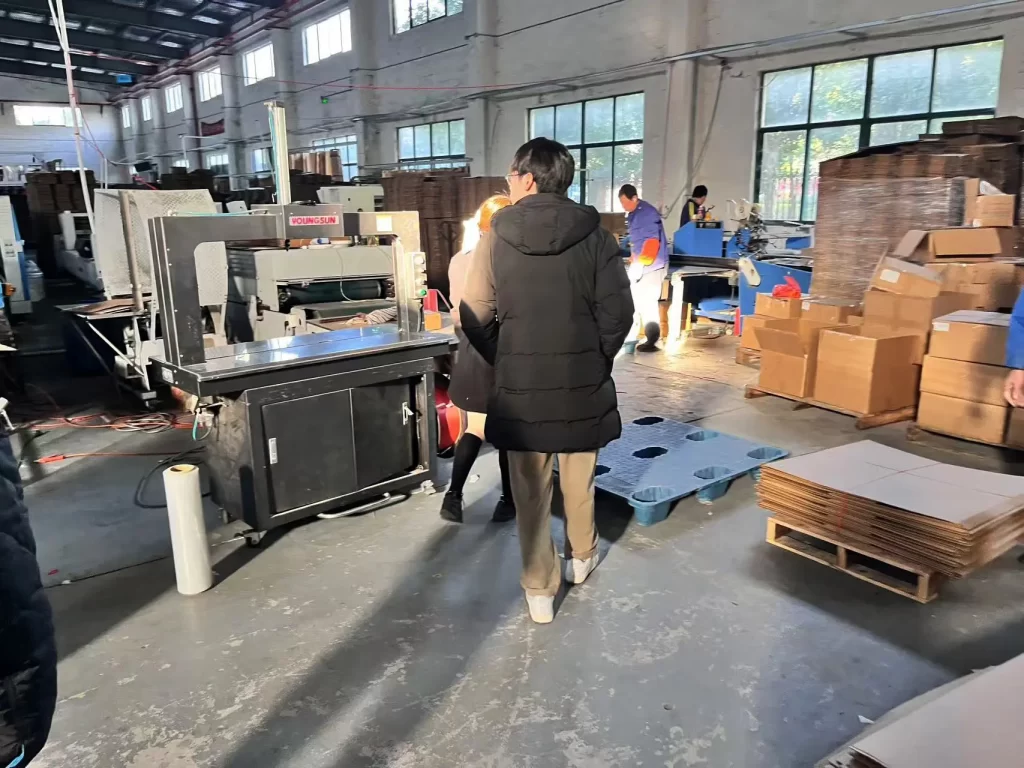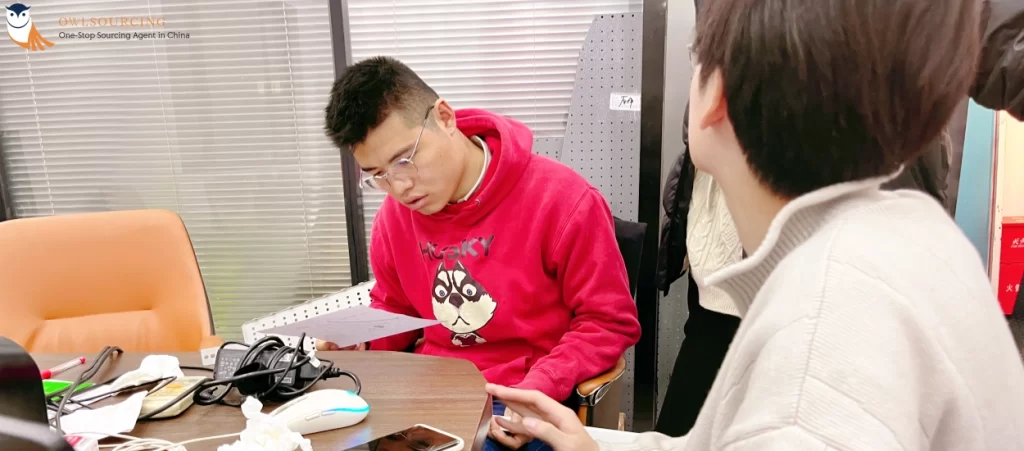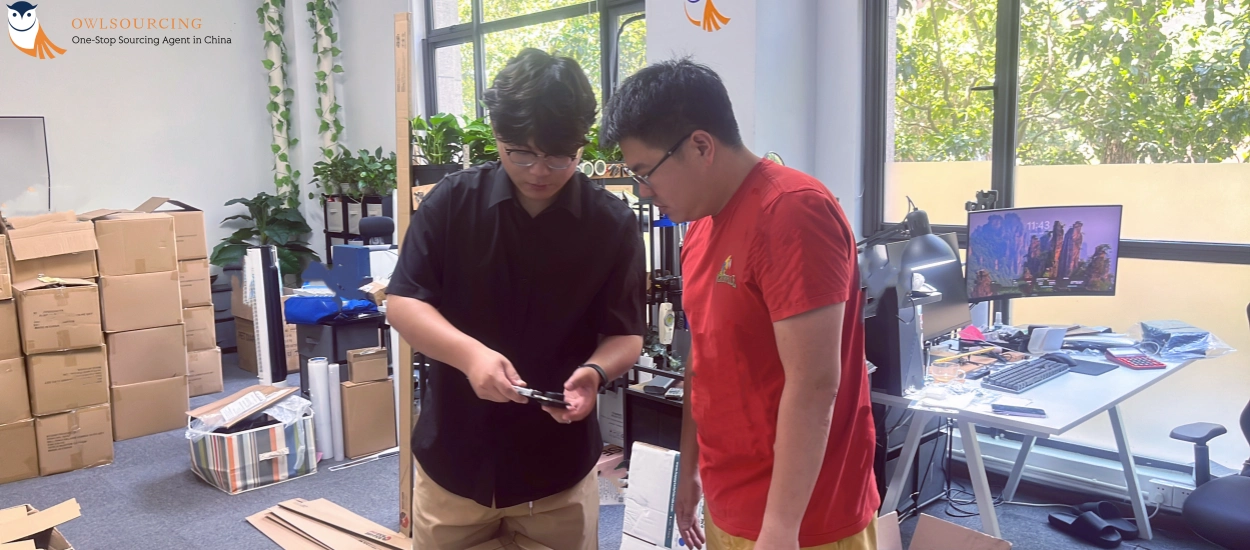In this article, we aim to highlight the significance of quality control in China. Let’s start with a common, real-life scenario of most wholesale buyers in China.
Suppose this: You’ve acquired a good supplier in China, negotiated a good bargain, and are eagerly anticipating your first shipment. But when they arrive, the goods are riddled with defects, faulty components, irregular sizes, or worse yet, non-compliance with your domestic laws.
Suddenly, you’re facing thousands in returns, scathing customer reviews, and a tarnished brand. This nightmare, all too common for unprepared importers, is a stark reminder that quality control in importing from China is not optional.
QC is the backbone of a successful sourcing strategy. Without it, the cost savings of manufacturing in China can quickly turn into costly setbacks.
QC isn’t a step—it’s your brand’s protection!
Quality control (QC) means inspecting and testing goods at every key stage—
 pre-production
pre-production
 in-process
in-process
—to catch and fix defects before they ever reach your customers.
Let’s share a recent project with you:
One of my German Amazon clients almost received kitchenware with flimsy handles.
Early purchasers would have ruined them with negative reviews if that batch had shipped. Before the first day, the game is over.
We found the flaw, fixed it, and preserved the launch thanks to OwlSourcing’s quality control inspection in China.
No refunds. No reputation damage. Just smooth sales from day one.
So yeah — one inspection can save your brand.
You can rely on OwlSourcing if you require quality control in China.
We are physically present in the factories, ensuring that your products ship correctly the first time.
Forget about China sourcing without quality inspection—it’s a recipe for disaster

Customer returns, refund requests, negative reviews, and long-term brand damage are typically the price of cutting corners.
Unbelievable but true, I once had a client who purchased 1,000 glass jars without inspection. Upon delivery, they discovered that 35% were chipped, scratched, and dirty. What happened? Delays in deliveries, costly replacements, and complaints marred their sales record.
In one instance, the electronics shipment arrived 20% defective; some of the products were missing key components in the final packaging. That mistake alone accounted for over $10,000 in returns and customer confidence loss.
On the other hand, instituting quality QC in the form of pre-shipment inspections, product specifications, and qualified suppliers can reduce defects by 99%. It also ensures that your products meet definitive platform requirements on Amazon, Shopify, or TikTok Shop, where early reviews have a direct influence on long-term success.
At OwlSourcing, we also maintain an in-house inspection team to assist you in finding and fixing quality problems before shipping from China, so that you do not have to pay for it afterwards.
Our inspection data shows thata 10% defect rate is not uncommon, and as highlighted in our previous article, sourcing directly from platforms like Alibaba carries significant risks.
Data-Driven Impact of Effective QC
Did you know? Third-party inspection can reduce defect rates by up to 35%, based on industry research.
The quality requirements are different for different products. In the case of wood products, defining acceptable natural grain patterns, knots, insect marks, colour variation, and hardness is most important in creating an acceptable inspection standard for all.
The Strategic Role of Quality Control in Chinese Sourcing
Quality control presents unique challenges that can ruin your plans if not met. Understanding these challenges is the secret to success over them.
Quality control is not defect checking—it is a competitive advantage. It guarantees reliability, customer satisfaction, and business scalability when selling through online marketplaces like Amazon, Shopify, or TikTok Shop.
Below are the most common challenges and how to succeed over them:
- Ensuring Product Reliability: QC guarantees function and safety, whether functional circuits for electronics or adequate stitching in apparel.
- Compliance with Laws: Western markets require absolute compliance with FDA, CE, or RoHS mandates. QC guarantees certified reports and compliant components.
- Minimising Financial Risk: Defects incur 20–30% additional costs by way of rework, refund, and delay.
- Simplifying Operations: Prevents launch bugs, backorders, and recalls.
- Encouraging Supplier Responsibility: QC calls for uniform quality performance.
- Enabling Scalability: Scale securely, knowing orders of greater size will be the same.
Let me explain in-depth:
Blending Client and Supplier Needs
Effective QC is about understanding how to set standards that are client-preferred but feasible for suppliers. High standards can cost more for suppliers, and hence create tension.
Unreliable Manufacturing Standards
Some Chinese suppliers put speed ahead of accuracy, applying a “good enough” attitude that leads to errors or non-compliance with Western standards.
For instance, a supplier may employ lower-quality materials to save money and accept that there would be imperfections. This misfit can create products that are non-conforming to U.S. or EU requirements, resulting in holdups and returns.
Navigating Language Barriers in QC in China
Misinterpretation by product specs, most of the time by open-ended translations, results in less-than-impressive products. An importer seeking to order bespoke packaging can be provided with incorrect colours or sizes due to mistranslated briefs.
Phone calls are sometimes necessary in spite of AI tool capabilities.
China agents’ efficient English-speaking personnel enable suppliers to gain a better understanding of foreign customers’ detailed product specifications, reducing errors.
Managing Geographic Distance in Quality Control in China
Geographic distance is hard to control. Factories thousands of miles away are a nightmare for monitoring in real time, so the importers have no choice but to rely on remote inspection. Time zones also make communication slower, with the added risk of defects going undetected.
OwlSourcing, being local to Shanghai, can provide ground-level support, in-process and pre-shipment quality checks to detect faults early on, saving your time and the cost of commuting.
If our team identifies an issue, our quality team will be at the factory’s doorstep the next morning to resolve it.
Common Pitfalls We Overcame
| Challenge | Impact | Solution |
|---|---|---|
| Inconsistent Standards | Defects, returns | Define specs, run pilots |
| Language Barriers | Miscommunication | Use bilingual agents + visuals |
| Geographic Distance | Delayed action | Local inspections + next-day factory access |
| Regulatory Risks | Fines, recalls | Verify certifications, lab tests |
| Cultural Gaps | Misaligned expectations | Translate standards into supplier language |
How to Guarantee Product Quality When Importing from China

China’s import quality control guarantees your products are up to standard, defect-free, and safeguards your brand. OwlSourcing makes it easy with efficient verification processes:
1. Apply Standardised Testing: Test performance, durability, and safety using ASTM, ISO, or equivalent techniques. For electronics, battery lifespan; for clothing, tensile strength and colourfastness.
2. AQL Sampling: Sample based on AQL levels and defects classification for an order of 1,000 pieces. From a shipment of furniture, 5% defective finish was found—repaired all before shipment.
3. Authenticate Certifications: Check for authenticity always. For a customer supplying kitchenware, OwlSourcing checked FDA compliance to ensure the coatings are safe for use.
4. Check Packaging and Labelling: Packaging mistakes are a waste of money. We saved one toy client $8,000 by detecting mislabels. For apparel, we examined protective packaging that prevented shipping damage.
5. Conduct Factory Audits: OwlSourcing discovered an old, dusty loom in one factory, enabling a textile client to avoid a low-capacity supplier.
6. Third-Party Laboratory Testing: Cosmetic, pharmaceutical, or food-grade items could require lab testing. OwlSourcing organises TUV, SGS, BV, and Intertek testing.
7. Leverage Technology: 20% reduction in defects with AI-based solutions. Real-time inspection reports through our apps.
8. Report Analysis of Inspection: Photographs, defect reports, and suggestions facilitate fast, well-informed decisions.
By including testing, sampling, certification, audit, lab testing, technology, and reporting, you ultimately confirm quality. The tailored services of OwlSourcing provide for this and render verification cost-effective.
Our on-the-ground presence and data-driven approach ensure that your products meet customer expectations and bring success to China sourcing.
Best Practices for Effective Quality Control
Successful quality control for China sourcing is a systematic process to facilitate the supply of quality, consistent products. The best practices, based on industry standards and the experience of OwlSourcing, to help you achieve success are as follows:
1. Supplier Screening: The foundation of quality control is good supplier selection. All factories are not equal—some prioritise quality, while others cut corners. Verify supplier authenticity using:
- Certifications: Seek ISO 9001 or industry-specific certifications to ensure standardised processes.
- Background Checks: Verify business licenses, export history, and customer references to ensure credibility (Suppliers with predominantly U.S. or EU customers are likely to prioritise quality)
- Factory Audits: Assess facilities, equipment, and labour capabilities.
OwlSourcing conducts on-site audits, examining production capacity and quality systems. On-site factory visits reveal actual conditions, more than photos and videos on websites present. How else can you be certain of their accuracy?
For apparel, we check stitching and sizing; for electronics, we verify functionality. Our reports include photos, measurements, and defect rates, allowing you to address problems early.
2. Pre-Production Planning: Create clear specs—from materials to tolerances. Include diagrams or prototypes.
For electronics, specify battery life, safety features, and packaging requirements. OwlSourcing helps develop thorough specs, so suppliers are reading from the same page as you.
We also examine pre-production samples to confirm feasibility before large-scale production. This ensures material accuracy from the very beginning.
We helped a client coordinate suppliers to FDA-compliant kitchenware specifications.
3. In-Process Inspections: Identify problems before final assembly. For lighting, this saved a client the cost of redoing 300 faulty fixtures.
For instance, during furniture production, check wood quality and joinery before finishing.
OwlSourcing’s in-process inspections identify problems like incorrect materials or poor workmanship with time for correction before completion. This saved a client from purchasing lighting fixtures by redoing 300 faulty units.
4. Pre-Shipment Inspections: Final batch inspections utilising AQL, so there are no surprises.
OwlSourcing’s pre-shipment inspection uses statistical sampling (e.g., AQL standards) to arrive at defect rates, ensuring reliability. As a toy importer, we caught non-compliant labels, preventing a $10,000 recall.
Checklist for QC:
- Set standards against market norms.
- Audit and screen suppliers.
- Advance testing of samples.
- Stage-by-stage inspection planning.
- Document and regulatory checks.
Practical Steps to Implement Quality Control
Step 1: Define Requirements: Detail technical specs, material, size, and compliance standards (e.g., CE, FDA).
Step 2: Select Verified Suppliers: Filter production capacity and review past performance. We carry out virtual tours as needed.
Step 3: Schedule Inspections: Schedule pre-production, in-process, and pre-shipment inspections.
Step 4: Leverage Data-Driven Reports: Analyse defects, monitor KPIs, and improve processes. Our reports include photos, defect quantity, and recommendations.
Additional Tips:
- Always make a signed sample before mass production.
- Maintain open communication channels with suppliers.
- Modify your QC plan based on historical trends.
- Common Pitfalls and How OwlSourcing Addresses Them
Benefits of Using a China Sourcing Agent for Quality Control
In my previous article, I listed several advantages of a China sourcing agent; now we are going to focus on the quality control:
1. Many Chinese factories have different standards from those in the U.S. or Western European markets.
The suppliers might find minor cosmetic flaws to be acceptable, but U.S. consumers expect perfection.
This largely results from varying cultural definitions of acceptable quality. One of the main functions of a China sourcing agent is to be able to properly communicate client quality expectations to suppliers so that they know and produce to the given requirements.
2. Compliance with regulations, for example, FDA quality for food products or CE marking for electronics, adds to the complexity, as suppliers may not necessarily comprehend such requirements.
To some suppliers, what is being tested and what is produced when they manufacture are not the same, so a sourcing agent must be sure that testing and certifying standards are consistently applied.
3. Prioritising speed at the expense of accuracy causes confusion. QC is typically a reaction that looks back after pre-shipment inspection, but the issue is ensuring the supplier fully understands detailed quality requirements, such as acceptable scratch limits or specific tolerances.
4. Unclear or poorly translated specifications result in non-compliant products. A sourcing agent must thoroughly understand client requirements, specifications, certifications, and testing requirements so that factories can supply compliant products.
Custom Quality Control Services at OwlSourcing
OwlSourcing addresses such issues through proper quality control services to fulfil importers’ specifications. Our China-based professional staff conducts systematic examinations, verifies supplier qualifications, and confirms conformity with international standards.
We help you determine proper product specifications like material, size, and performance needs based on ISO 9001 as a reference.
We also confirm adherence to certifications like FDA, CE, and RoHS to protect you from regulatory issues and legal breaches, especially when purchasing sensitive goods like kitchenware.
For instance, while procuring clothing, we ensure things like stitching quality and uniformity of the dye are properly specified.
A second great benefit of employing a China sourcing agent like OwlSourcing is the possibility to outsource difficult quality issues to professionals, since suppliers are often not cooperative in fixing quality issues.
We act as a mediator, smoothing working relationships. Our minute reports enable you to make wise decisions.
OwlSourcing ensures your products meet market standards for small or large orders.
We overcome common sourcing problems such as inconsistent manufacturing practices, language barriers, and inadequate on-site observation.
Our local inspectors, who are bilingual, use visual tools like sketches and prototypes to ensure your specifications are understood by suppliers.
Pre-production, in-process, and pre-shipment inspection is carried out by our local inspectors, and live reports complete with photos spare you the hassle of repeated foreign travel. We once saved a customer $5,000 for furniture by detecting surface blemishes early in production.
With a data-driven approach and expert audits, OwlSourcing redefines QC as a strategic advantage rather than a cost centre.
By partnering with us, you get access to local expertise, cost-effective inspections, and a commitment to excellence, allowing your sourcing experience to be seamless and successful. Contact us today!
In-House vs. Third-Party Quality Control
Choosing between in-house and third-party quality control impacts cost, objectivity, and scalability. The table below compares these options, followed by a comprehensive explanation.
| Aspect | In-House Inspection | Third-Party Inspection |
| Cost | Higher (travel, staff) | Lower (per inspection) |
| Objectivity | Risk of bias | Unbiased, professional |
| Expertise | Limited to team knowledge | Industry-specific experts |
| Scalability | Resource-intensive | Flexible, scalable |
Third-party inspections, like those offered by OwlSourcing, are more efficient. Costs are per inspection, typically a fraction of your travel expenses, making them ideal for small to medium businesses.
OwlSourcing’s inspections are conducted by unbiased professionals with industry-specific expertise, ensuring thorough and reliable assessments.
For example, when sourcing electronics, our inspectors test circuit boards, safety features, and packaging, catching issues your team might overlook. Third-party services are scalable, allowing you to inspect multiple orders across suppliers without straining your resources.
Our inspectors understand regional manufacturing practices and cultural nuances, providing accurate evaluations. For a furniture importer, we caught defective hinges during a pre-shipment check, saving $3,000 in returns.
Our reports include photos, videos, and defect data, giving you clear, actionable insights to address with your supplier.
FAQs: Your Questions About Quality Control Answered
- What are the common quality issues in China sourcing?
Defective materials, inconsistent production, and non-compliance with Western regulations are frequent issues. OwlSourcing’s inspections catch these early to prevent costly errors. - How much do third-party inspections cost?
Costs vary based on product complexity and inspection scope. Contact us for a detailed quote tailored to your needs. - How do I ensure compliance with international standards?
Verify supplier certifications, conduct audits, and use third-party inspectors like OwlSourcing to ensure adherence to FDA, CE, or other standards. - What’s the difference between quality control and assurance?
Quality control focuses on inspecting products for defects, while quality assurance improves processes to prevent defects. Both are critical for successful sourcing.
Read More:
- Quality Inspection for Pet Products in China
- How to Find a Reliable Sourcing Agent in China?
- Warranties & Refunds When Buying From China
- How to Import Toys from China
Final Thoughts
Improving the quality of Chinese imports is a wise investment that boosts competitiveness, consumer confidence, and financial prosperity. It releases expansion and reduces risk. OwlSourcing offers you expertly sourced solutions.
According to industry statistics, poor quality results in a 20–30% loss in margins from returns and lost sales. E-commerce brands are immobilised by negative reviews because 68% of consumers stop buying subpar products. Noncompliance will result in fines. These are avoided by QC, and third-party inspection lowers defects by 35%.
Travel expenses are eliminated by OwlSourcing’s site inspectors, and transparency is improved by our blockchain-based AI. Our relationship management holds suppliers responsible, and our reports help make informed decisions. To make QC affordable, we customise solutions for importers of all sizes.
Invest in QC to protect your bottom line and build confidence. Contact OwlSourcing to redefine your sourcing experience. Don’t let success be compromised by issues of quality—partner with us for a competitive edge.


